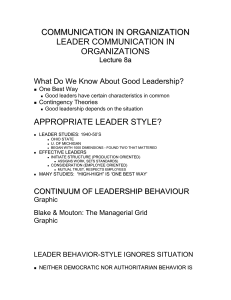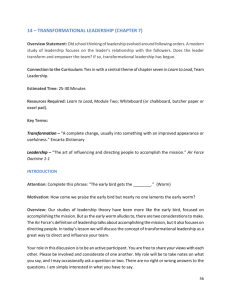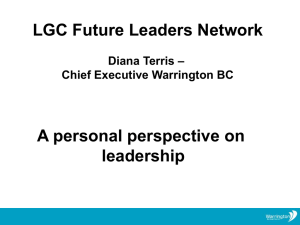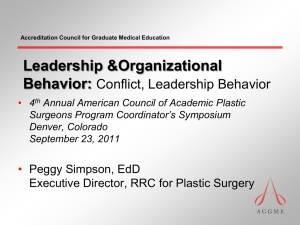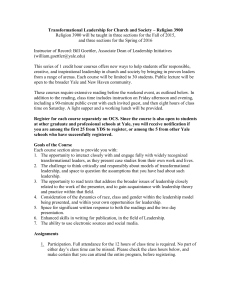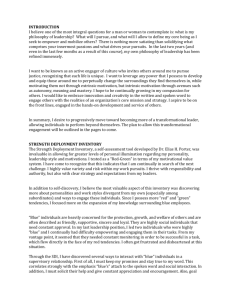1 CHAPTER 2 LITERATURE REVIEW 2.1 Study of Theory 2.1.1
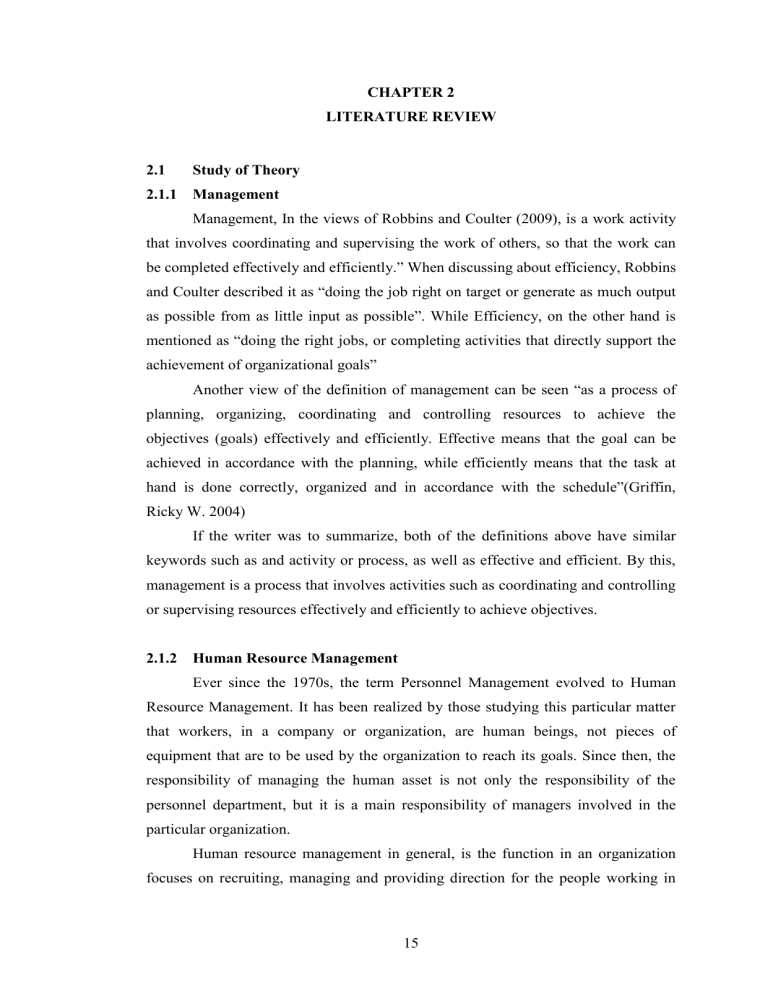
CHAPTER 2
LITERATURE REVIEW
2.1 Study of Theory
2.1.1 Management
Management, In the views of Robbins and Coulter (2009), is a work activity that involves coordinating and supervising the work of others, so that the work can be completed effectively and efficiently.” When discussing about efficiency, Robbins and Coulter described it as “doing the job right on target or generate as much output as possible from as little input as possible”. While Efficiency, on the other hand is mentioned as “doing the right jobs, or completing activities that directly support the achievement of organizational goals”
Another view of the definition of management can be seen “as a process of planning, organizing, coordinating and controlling resources to achieve the objectives (goals) effectively and efficiently. Effective means that the goal can be achieved in accordance with the planning, while efficiently means that the task at hand is done correctly, organized and in accordance with the schedule”(Griffin,
Ricky W. 2004)
If the writer was to summarize, both of the definitions above have similar keywords such as and activity or process, as well as effective and efficient. By this, management is a process that involves activities such as coordinating and controlling or supervising resources effectively and efficiently to achieve objectives.
2.1.2 Human Resource Management
Ever since the 1970s, the term Personnel Management evolved to Human
Resource Management. It has been realized by those studying this particular matter that workers, in a company or organization, are human beings, not pieces of equipment that are to be used by the organization to reach its goals. Since then, the responsibility of managing the human asset is not only the responsibility of the personnel department, but it is a main responsibility of managers involved in the particular organization.
Human resource management in general, is the function in an organization focuses on recruiting, managing and providing direction for the people working in
15
16 that particular organization. From the term itself, it is quite clear that human resource management concerns on the people factor of an organization. Below are some definitions that the writer have considered when trying to define the human resource management term.
According to Mondy (2010: 4-5) “human resource management is the utilization of individuals to achieve the organizational objectives”. In order for all individuals of the organizations to be able to be utilized optimally, managers of all strata needs to have at the very least the basic knowledge of human resource management. When they do, the delegation of tasks will be done effectively.
Byars and Rue (2006:4-5) on the other hand, defined human resource management as “activities designed to provide for and coordinate the human resources of an organization”. Human resource is considered to be a priced asset in most organizations and because it is looked as one of the most valuable asset, companies invest largely on its people. These investments include benefits and compensation, as well as trainings and developments in addition to the obligated salary and wages. In his book, he briefly mentioned that “approximately 65% of national income is used to compensate employees”
In Snell and Bohlander’s book, “Principles of Human Resource
Management” (2010:4) Human Resource Management is “ the process of managing human talent to achieve an organization’s objectives”. Like Mondy, Snell and
Bohlander seconded the importance of managing HR as being the responsibility of, and are relevant to, the line managers. So it can be said that it is not only the responsibility of the HR department in the organization, but the responsibility of all team leaders. Based on the framework for human resource management developed in this book, HR managers help blend the many aspects of management that are called competitive challenges and employee concerns. The way that HR managers blend these aspects is by making the most of the people they have in the company by providing a work environment that satisfies the employees’ short-term and long-term needs.
Human resource management is a function of the management processes, based on Dessler (2010). It is the “process of acquiring, training, appraising, and compensating employees, and attending to their labor relations, health and safety, and fairness concerns”. In other words, it is the policies and practices that is concerning the people in an organization.
17
As of the definitions above, the writer could find these key words that are present in the definitions; individuals or human resource or human talents or employees, process, goals or objective. Therefore, is safe to conclude that human resource management is the process or activity that manages human resources in an organization that aims to the fulfillment of the organizational goals.
2.2 Leadership
2.2.1 Leadership Definition
According to Peter G. Northouse (2010), Leadership is “a process whereby an individual influences a group of individuals to achieve a common goal.” In his book, he described leadership as a process because it is a transactiona l event that takes place between a leader and his/her follower rather than a characteristic or a trait within an individual.
However, Leadership, according to Robbins and Judge (2007), is not a process that a person goes through but rather an ability that one has to be able influence others towards the achievement of a vision or set of goals. In the book, it is said that although the source of influence could come from a managerial position that a person holds in an organization, it doesn’t mean that they would be able to lead effectively. This definition of leadership is one that is found from a nonsanctioned leadership, which is according to the book “is the ability to influence that arises outside the formal structure of an organization” which is equally as important as the formal influence that one receives from holding a managerial role in an organization.
Leaders are able to emerge from members of a group as well as by a formal appointment.
Lussier and Achua (2007), views that leaders are neither born nor identified by trait. This view, further supports Northouse’s leadership definition. However, common characteristics that effective leaders share might be the cause of why some people say “leaders are born.”
In the definitions above, few similar words are identified; trait, influence, group of individuals or others, and goals. Therefore, if the writer may conclude, leadership is cannot be seen as a trait or a characteristic of a person, but it is the ability of a person to influence a group of people in order to achieve a common goal.
18
2.2.2 Transformational Leadership
Some components of transformational leaders according to Bass and Riggio
(2006) are for example, Transformational leaders have idealized influence. This means that leaders are admired by their followers because they are seen as having astonishing capabilities, persistence and determination. Transformational leaders are looked up to or even idolized because they are serving as role models for their followers. Another component worth mentioning is that these leaders are inspirational motivation. They behave in a certain way that results in motivation and inspiration of their follower by providing meaning and challenge to their work.
What differs transformational leadership than other leadership style is that transformational leaders inspires their followers therefore, if inspired enough, followers tend to be able to achieve more things and to do things they don’t normally do (Evans, Jeff (2009). These leaders are clear in communicating their visions and commitment so that an association or connection is then created between a leader and his or her followers. Transformational leaders inspires other because the express their personal passions and were able to engage others with the same or similar passion.
What does inspiration of these leaders do for its followers? They somehow are able to make these individuals visible and presence is recognized. When someone is inspired, a sort of positive energy is somewhat extorted and makes them delightful to be around. When leaders’ presence brings positive feelings towards others, then their opinions, desires, and instructions are much easier for others, for example followers, to accept. This presence are what is called inspirational presence. Inspirational presence is the ability to connect authentically with others; to use our thoughts, feelings and intuitions to guide action toward our deepest sense of personal mission
(Evans, Jeff (2009)
In a book by Robins and Judge (2007), mentioned two inspirational approaches to leadership; charismatic leadership and transformational leadership.
These two approaches both has the essence of being able to influence the leaders followers. But what will be discussed here is regarding the transformational leadership approach. Transformational leadership differs from transactional leadership where, transactional leaders “guide or motivate their followers in the direction of the established goals by clarifying role and task requirements” and transformational leaders are leaders who are able to inspire their followers to look beyond their self-interest for the good of the organization and these leaders have a
19 somewhat an extraordinary effect on their followers. This is because not only these leaders are focused and are able to coordinate their people towards the organizational goals, they also play close attention to the needs, concerns as well as development of their people.
Similar keywords could be found in the definitions above. These words are inspire, followers, and goals. So, transformational leaders are those who are able to inspire and motivate their followers towards the accomplishment of certain goals that has been set.
2.2.2.1 The Dimensions of Transformational Leadership
Robbins and Judge (2007: 387) described the characteristics of a transformational leader as :
Idealized Influence: the leader provides vision and mission, inspires pride, and is able to gain respect as well as trust from their followers
Inspirational Motivation: the leader communicates high expectation towards their followers, uses symbols to focus efforts, and they are always communicating and expressing important purposes in a way that is easy for the followers to comprehend.
Intellectual Stimulation: transformational leaders stimulate intelligence of its members as well as rationality and careful problem solving.
Individualized consideration: transformational leaders are very attentive in a personal way and treats their followers equally, they also coach and give advices
2.3 Organizational Commitment
2.3.1 Organizational Commitment Definitions
As mentioned in a study case by Derek Shaun Cortez, when trying to understand organizational commitment, it is best to see it as a collection of commitments. Commitments can vary from: a) affective commitment: an employee’s emotional attachment to, identification with and involvement in the organization b) continuance commitment: an awareness of what will cost the employee if they were to leave the organization
20 c) normative commitment: the feeling of obligation to continue their period of employment in an organization.
To put it simply, organizational commitment is an employee’s affective reaction to their organization as a whole. Employees who feel committed to their organization mostly are attached to their organization that the organizations goals and values become their own. This is called identification. Other than that, they intend to remain in the organization or feel loyal to the organization, Lastly, employees who are committed to their organization shows citizenship behaviour, where they show high levels of extra role behaviour (behaviour that is more than the required performance)
Organizations that are commitment-based usually use an integrated method in order to increase commitment in their organization. For example, in terms of employee motivation, the company chooses to implement the Theory Y assumption where rewards are used to enhance performance of their employees. Also, instead of defining minimum expected performance standards, commitment-based companies usually set “growth” objectives. Lastly, the work life balance, or rather, quality is set to be an important organization goal.
Robbins and Judge (2008) in “Essentials of Organizational Behaviour”, describes organizational commitment as the degree that an employee favors the organization they’re involved in along with the organizational goals and the willingness of this employee to retain their membership in the organization.
Mathis and Jackson (2006:122) defines organizational commitment as the degree or level where an employee trusts and accepts the organizational goals, and is willing to stay in the organization. Studies shows that employee who are satisfied of their job are more committed to the organization compared to those who aren’t satisfied with their job.
Robbins and Judge (2007) explained that organizational commitment is another example of work-related attitude besides job satisfaction and job involvement. It is defined as “a state in which an employee identifies with a particular organization and its goals and wishes to maintain membership in the organization
Words such as goals or objective, or affective or attachment, as well as remain or retain is available from the definitions above. Therefore, the writer wishes to conclude that organization commitment is when a member of an organization feels
21 an attachment to the organization as well as its goals and they are voluntarily willing to remain in the organization.
2.3.2 Dimensions of Organizational Commitment
In a journal by Dr. Rashid Saeed et all (2013) Mowday, Porter & Steels explains that organizational commitment is characterized with:
Identification: A strong belief in acceptance of the organization’s goals and values.
Involvement: A willingness to exert considerable effort on behalf of the organization.
Loyalty: A strong desire to maintain membership in the organization.
These characterizations of organizational commitment will be used as dimensions in this thesis.
2.4 Empowerment
Robbins & Coulter (2009) mentions that empowerment involves the improvement of decision making discretion for workers.
Robbins and Judge (2007) speaks about empowerment in their book
Organizational Behavior. Ever since the 1980s, where managers are enforced to get their subordinates to be more involved with work-related decisions, the lines between the role of a manager and their subordinate is becoming more haze as more and more companies are implementing self-managed teams. When empowering an employee, it means that employees are being put in charge for the things they do and so they are pushed to take the responsibility for their work and take on the challenge of decision making. Managers are required to delegate their responsibility and learn how to give up control over their subordinates
Empowerment, according to Byars and Rue (2006), is a “form of decentralization that involves giving subordinates substantial authority to make decisions”. It can be said that this approach, along with self-managed work teams have a somewhat significant impact in managing human resources. This is because when empowerment is implemented by a team leader towards their subordinates, it expresses a sense of confidence and trust in the ability of employees to perform at high levels.
22
Then, according to Snell and Bohlander (2010) in their book principles of
Human resource Management, “employee empowerment is a technique of involving employees in their own work through the process of inclusion”. By empowering employees, it encourages subordinates to become innovators and develop a higher sense of responsibility towards their own work. Team leaders of an organization usually empower employees by giving them more control over jobs as well as autonomous decision making capabilities. In order for empowerment to grow and implemented successfully, organization must encourage participation of the employees so they would take control of their work tasks, an environment that allows employee to innovate and explore and take reasonable risks at reasonable costs, and an access to a variety of information.
Words such as decisions or decision making, authority or put in charge, as well as inclusion or involved could be found within the definitions above. So based on the definitions above, empowerment is a technique used by many organizations these days to include and give subordinates more authority and control over to make decisions.
2.4.1 Dimensions of Empowerment
Thomas and Velthouse, 1990 in a journal by Guangping Wang and Peggy
D.Lee (2009) mentioned that empowerment has 4 dimensions, which are:
1.
Meaning: the degree that an individual believes in and cares about goal purposes. Meaningfulness is judged in relation to an individual’s own ideals or standards of need
2.
Competence: this refers to self-efficacy specific to work and is rooted in an individual’s belief in in his or her knowledge and capability to perform task activities with skill and success
3.
Choice: this represents the degree to which an individual feels causal responsibility for work-related actions, in the sense of having choice in initiating and regulating action.
4.
Impact: the experience of having an influence on strategic, administrative or operating outcomes at work to make a difference
23
2.5 Theoritical Framework
This research paper is entitled “ Analysis of impact of Transformational
Leadership and Employee Empowerment on Organizational Commitment of
PT Pricol Surya
” with the intention of measuring Transformational leadership (X1) and employee empowerment (X2) as independent variable towards organizational commitment (Y) as the dependent variable. The theoretical framework of this paper is as follows:
Transformational
Leadership (X1)
Empowerment (X2)
Organizational
Commitment (Y)
Source: author
Figure 2.1 Diagram Theoritical Framework
2.6 Hypothesis Design
Objective – 1
H o
: Transformational leadership does not impact Organizational Commitment
H
1
: Transformational leadership impacts Organizational Commitment
Objective – 2
H o
: Empowerment does not impact organizational Commitment
H
1
: Empowerment impacts organizational commitment
24
Objective – 3
H o
: transformational leadership and Empowerment does not impact organizational commitment
H
1
: transformational leadership and Empowerment does impact organizational commitment
